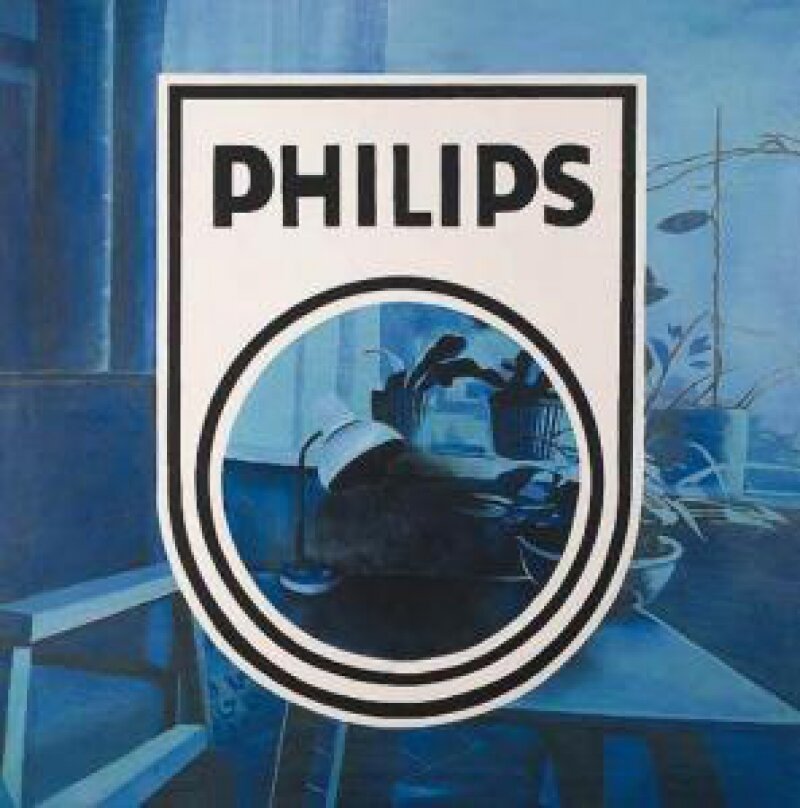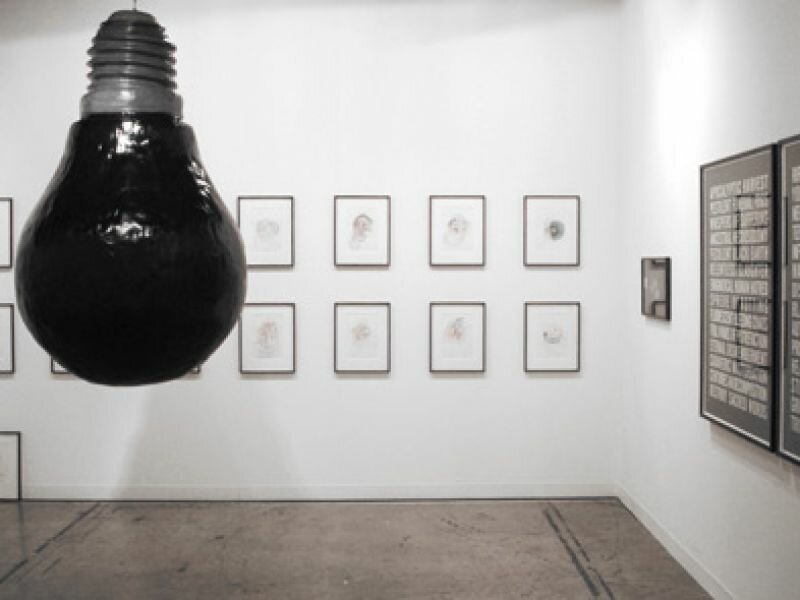
Zwart licht, 1984
Rob Scholte
The most interesting artists are always those who attempt the impossible. For example, they might hear someone from the largest lamp factory of the world say: “It’s impossible to make grey light, we’ve tried it in every way possible, but it’s impossible!” and immediately they’ll think, “Oh really? We’ll see about that!” The American James Turrell is one of these artists. He quite easily managed to succeed where Philips failed. He threw together a few fluorescent tubes, light bulbs, filters, and then— lo and behold! Light of the purest grey.
Of course, this is no small feat and it immediately poses the question if the same is possible with black light. The likelihood of this possibility is quite slim because “black” insinuates “to absorb light.” How could one ever create a light that absorbs light?
Dutch artist Rob Scholte once made a painting of black light (Nachtlicht, 1984). A large Philips logo is depicted, and through its round hole a desk lamp is visible, emanating a black smudge as though it were a soot-spewing chimney. It’s an interesting image but it remains a painted representation, whereas Turrell manages to create actual light. Nevertheless, Scholte’s black light became slightly more real when a postcard of the painting found its way to Philips, upon which the company ignited in anger. Ridiculously, the multinational’s lawyers demanded that the postcard be taken off the market. As if they could forbid artists to play on the grounds that they had left in frustration.
Philips did, by the way, successfully develop a Black Light that differs from the above connotation of black light. Black Light is the name for lamps that only emit a very small portion of the colour spectrum, namely theultraviolet range. Everyone knows these lamps from discos, for example. But in the disco, this light reflects offa multitude of people and objects. This will make you experience the light as strange, but definitely not as black. To experience the light as black, you’d have to empty the entire room and even cover the walls.

Douglas Gordon, a Scottish artist, did something similar in his installation Black Star (2002). The light in this room is extremely frightening; it’s almost like looking through an X-ray where every hair on your clothes, every flake of skin, every other visitor seems like a spectre. The artist’s voice resonates from hidden speakers and reads from the 19th century horror novel “Confessions of a Justified Sinner” by James Hogg. The space seems formless and without a single thing for your vision to latch onto, until you’re standing in the exact centre of the room, and you find yourself in the middle of a five-pointed star—the symbol of the devil. It’s literally and figuratively a black artwork.
For a while, it seemed as though the scientists would provide a clever answer to the black light question. On September 9th, 1987, the American James DeLucas published an article titled, “Definition of a Darkbulb”. The first sentence was: “The Darkbulb is an electronic device that produces darkness”. The rest of the article describes the specific workings of the black bulbs, which new and which old technology it uses, that the invention would allow one to take a nap in the middle of the day in the dark by pressing the light switch and so on.

Unfortunately, it turned out that the article came from the Journal of Irreproducible Results, and so nothing more was ever heard of the Darkbulb. Apparently, we shouldn’t expect anything from scientists or the lamp factories, meaning we have only the artists to rely on. This is actually very logical, since the greatest desire for the black light has been within circles of artists. Last year, the Swiss Ugo Rondine expressed this desire by building a two-meter high black light bulb, as if to say: if I can’t make a lamp that fills the room with darkness, I’ll make a dark lamp that fills the room with itself.
There’s a great chance that given the time, the artists will eventually produce an unexpected and inventive solution. Although scientists and light technicians have a much more extensive theoretical basis, artists are more flexible in their approach and dare to oppose conventional thinking. Some day, artists might just decide to create black light by placing the light switch on the person instead of on the wall. One press of the button and your eyes would roll backwards and immerse you in a delightful darkness. You’d be like the man in Blind Ernest (White), a photograph by Douglas Gordon, whose eyes are white, without iris. Ernest smiles happily, in complete contention in his black light.
There’s still no definitive answer to the problem, until now every solution is based on excluding white light, and black light still isn’t being made. But that’s the way it goes in art, the problem stays, it never stops, it never ends.